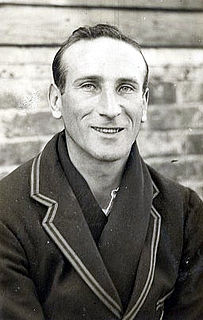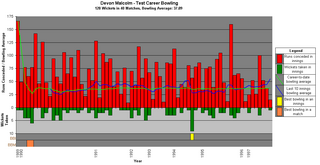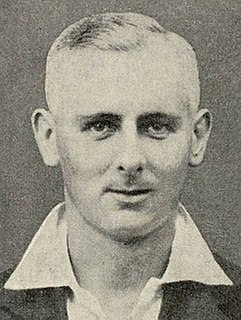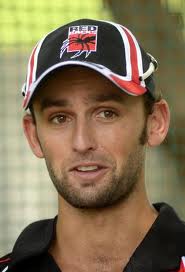Related Research Articles

Bodyline, also known as fast leg theory bowling, was a cricketing tactic devised by the English cricket team for their 1932–33 Ashes tour of Australia, specifically to combat the extraordinary batting skill of Australia's Don Bradman. A bodyline delivery was one where the cricket ball was bowled at the body of the batsman, in the hope that when he defended himself with his bat, a resulting deflection could be caught by one of several fielders standing close by.

Douglas Robert Jardine was a cricketer who played 22 Test matches for England, captaining the side in 15 of those matches between 1931 and 1934. A right-handed batsman, he is best known for captaining the English team during the 1932–33 Ashes tour of Australia. During that series, England employed "Bodyline" tactics against the Australian batsmen, wherein bowlers pitched the ball short on the line of leg stump to rise towards the bodies of the batsmen in a manner that most contemporary players and critics viewed as intimidatory and physically dangerous. Jardine was the person responsible for the implementation of Bodyline.

Stuart Charles Glyndwr MacGill is an Australian former cricketer who played 44 Test matches and three One Day Internationals for the Australian national cricket team. He is a right-arm leg spin bowler, who has been credited with having the best strike rate of any modern leg-spin bowler, but he did not have a regular place in the Australian Test team due to the dominance of Shane Warne in the position of sole spinner. His bowling was slightly slower through the air than Warne's, but he was a prodigious turner of the ball.

Devon Eugene Malcolm is a former English cricketer. He played in 40 Test matches for his adopted country, but took part in just ten One Day Internationals.

Hedley Verity was a professional cricketer who played for Yorkshire and England between 1930 and 1939. A slow left-arm orthodox bowler, he took 1,956 wickets in first-class cricket at an average of 14.90 and 144 wickets in 40 Tests at an average of 24.37. Named as one of the Wisden Cricketers of the Year in 1932, he is regarded as one of the most effective slow left-arm bowlers to have played cricket. Never someone who spun the ball sharply, he achieved success through the accuracy of his bowling. On pitches which made batting difficult, particularly ones affected by rain, he could be almost impossible to bat against.
Raymond Illingworth CBE is a former English cricketer, cricket commentator and cricket administrator. As of 2015, he is one of only nine players to have taken 2,000 wickets and made 20,000 runs in first-class cricket. He played for Yorkshire, Leicestershire (1969–78) and England (1958–73) and was a Wisden Cricketer of the Year in 1960. He was born in Pudsey, West Riding of Yorkshire. He is currently the oldest living cricketer who had played at least one ODI.

Robert Peel was an English professional cricketer who played first-class cricket for Yorkshire between 1883 and 1897. Primarily a left-arm spin bowler, Peel was also an effective left-handed batsman who played in the middle order. Between 1884 and 1896, he was regularly selected to represent England, playing 20 Test matches in which he took 101 wickets. Over the course of his career, he scored 12,191 runs and took 1,775 wickets in first-class cricket. A match-winning bowler, particularly when conditions favoured his style, Peel generally opened the attack, an orthodox tactic for a spinner at the time, and was highly regarded by critics.

George Henry Stevens "Harry" Trott was an Australian cricketer who played 24 Test matches as an all-rounder between 1888 and 1898. Although Trott was a versatile batsman, spin bowler and outstanding fielder, "... it is as a captain that he is best remembered, an understanding judge of human nature". After a period of some instability and ill discipline in Australian cricket, he was the first in a succession of assertive Australian captains that included Joe Darling, Monty Noble and Clem Hill, who restored the prestige of the Test team. Respected by teammates and opponents alike for his cricketing judgement, Trott was quick to pick up a weakness in opponents. A right-handed batsman, he was known for his sound defence and vigorous hitting. His slow leg-spin bowling was often able to deceive batsmen through subtle variations of pace and flight, but allowed opposition batsmen to score quickly.
Jack Birkenshaw, was an English cricketer, who later stood as an umpire and worked as a coach. Cricket commentator, Colin Bateman, stated "Jack Birkenshaw was the epitome of a good all-round county cricketer: a probing off-spinner who used flight and guile, a handy batsman who could grind it out or go for the slog, a dependable fielder and great competitor".

Maurice Leyland was an English international cricketer who played 41 Test matches between 1928 and 1938. In first-class cricket, he represented Yorkshire between 1920 and 1946, scoring over 1,000 runs in 17 consecutive seasons. A left-handed middle-order batsman and occasional left-arm spinner, Leyland was a Wisden Cricketer of the Year in 1929.

Amit Mishra
Roy Tattersall was an English cricketer who played for Lancashire and played sixteen Tests for England as a specialist off spin bowler. He was born at Tonge Moor, Bolton, Lancashire, England.

Terrence James Jenner was an Australian cricketer who played nine Tests and one ODI from 1970 to 1975. He was primarily a leg-spin bowler and was known for his attacking, loopy style of bowling, but he was also a handy lower-order batsman. In his latter years he was a leg-spin coach to many players around the world, and a great influence on Shane Warne. He was also a radio cricket commentator for the Australian Broadcasting Corporation.

Leslie O'Brien "Chuck" Fleetwood-Smith was a cricketer who played for Victoria and Australia. Known universally as "Chuck", he was the "wayward genius" of Australian cricket during the 1930s. A slow bowler who could spin the ball harder and further than his contemporaries, Fleetwood-Smith was regarded as a rare talent, but his cricket suffered from a lack of self-discipline that also characterised his personal life. In addition, his career coincided with those of Bill O'Reilly and Clarrie Grimmett, two spinners named in the ten inaugural members of the Australian Cricket Hall of Fame; as a result he played only ten Test matches but left a lasting impression with one delivery in particular. His dismissal of Wally Hammond in the fourth Test of the 1936–37 Ashes series has been compared to Shane Warne's ball of the century. He has the unwanted record of conceding the most runs by a bowler in a Test match innings.
Edward Ernest Hemmings is a former English cricketer, who played in 16 Test matches and 33 One Day Internationals for the England cricket team between 1982 and 1991. He made his England debut relatively late in his career, at the age of 33, having predominantly represented Nottinghamshire in the County Championship. His chance came when several England players announced their intention to go on a rebel cricket tour to South Africa.
The England cricket team toured Australia during the 1982–83 season, playing a five-Test series for The Ashes and a number of tour matches against Australian domestic teams. They also played a triangular One-Day International (ODI) series against Australia and New Zealand.
Jason John Krejza is a former Australian cricketer. He played for the Tasmanian Tigers and Leicestershire. Krejza's father was an association football player from Czechoslovakia and his mother was born in Poland. His nickname is "Krazy".
Doug Ring was a member of Donald Bradman's famous Australian cricket team which toured England in 1948. Bradman's men went undefeated in their 34 matches; this unprecedented feat by a Test side touring England earned them the sobriquet The Invincibles.

Nathan Michael Lyon is an Australian international cricketer. He made his Test debut in 2011 and plays domestic cricket for New South Wales. Lyon is an off spin bowler and a lower-order right-handed batsman. As of June 2020, Lyon is the 16th-ranked Test bowler and 20th-ranked Test all-rounder in the world, according to the ICC Player Rankings. Considered the most successful off-spin bowler for Australia, Lyon holds the record for the most Test wickets taken by an Australian off-spin bowler, passing Hugh Trumble's 141 wickets in 2015..
John Stephen Manning, usually known as Jack Manning, was an Australian cricketer who played first-class cricket for South Australia and in England for Northamptonshire. He was born at Semaphore, South Australia and died at Adelaide, also in South Australia.
References
- 1 2 3 4 Coward, M. "Dolman, the wrong-un who has finally got it right", The Age, 13 January 1982, p. 23.
- 1 2 "Other Matches played by Malcolm Dolman". CricketArchive. Retrieved 8 October 2011.
- ↑ "Sri Lanka Under-19s v Australia Under-19s". CricketArchive. Retrieved 8 October 2011.
- ↑ Ryan, p. 128.
- ↑ S.A.C.A., p. 21.
- ↑ "South Australia v Queensland". CricketArchive. 2011. Retrieved 25 September 2011.
- ↑ S.A.C.A., p. 40.
- ↑ "SECOND ELEVEN CHAMPIONSHIP MATCHES PLAYED BY MALCOLM DOLMAN". CricketArchive. Retrieved 3 October 2011.
- 1 2 Frith, p. 179.
- ↑ "South Australia v England XI". CricketArchive. Retrieved 3 October 2011.
- 1 2 "Leading Teams Australia". Leading Teams. 2011. Retrieved 24 September 2011.